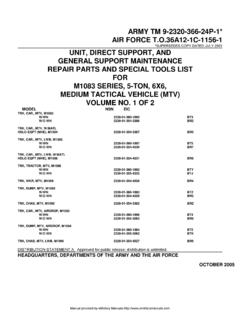Transcription of C:Documents and SettingsAlex J. BurwasserMy Documents …
1 RDF PRODUCTSV ancouver, Washington, USA 98682 Tel: +1-360-253-2181 Fax: +1-360-892-0393E-Mail: Website: Note BASICS OF THEWATSON-WATT RADIO DIRECTION FINDING TECHNIQUEThis Web Note discusses the basics of the Watson-Watt DF technique(the DF technique employed by all RDF Products DF equipment). Thematerial is presented in an easy-to-read format suitable for readers moreinterested in practical applications rather than a highly technical discussionof purely theoretical B01/12-06/wn002_apl_01 Copyright 2007 by RDF ProductsOriginal Writing: December, -- Copyright 2007 by RDF Products -- RDF Products Application keeping with RDF Products business philosophy that the best customer is well informed,RDF Products publishes Application Notes from time to time in an effort to illuminate variousaspects of DF technology, provide important insights how to interpret manufacturers' productspecifications, and how to avoid "specsmanship" traps.
2 In general, these Application Notesare written for the benefit of the more technical Products also publishes Web Notes, which are short papers covering topics of generalinterest to DF users. These Web Notes are written in an easy-to-read format for users morefocused on the practical (rather than theoretical) aspects of radio direction finding more technical discussion is required, it is presented in plain language with an absoluteminimum of supporting mathematics. Web Notes and Application Notes are distributed on theRDF Products Publications CD and can also be conveniently downloaded from the RDFP roducts website at About Adobe RDF Products publications are published as Adobe Acrobat portable documentation files(PDFs). Although Documents published in PDF format can be viewed on a wide variety ofcomputer platforms and operating systems, they require that the Adobe Acrobat Reader beinstalled on the recipient s computer.
3 This reader is free and a suitable version for almost anycomputer operating system can be downloaded from Adobe s website at the print quality of an Acrobat PDF document is unsatisfactory, check the the printer is Post Script compatible, use the Post Script print driver if possible. Thisusually results in best print quality. the most current version of the Acrobat Reader ( or higher) if contains specific improvements for better graphics printing quality and isstrongly recommended. It also provides improved print quality for the large number ofprinters employing HP PCL print Acrobat Documents produced by RDF Products have been carefully mastered for goodscreen and print quality as viewed on RDF Products computer -- Copyright 2007 by RDF Products -- of 10 - RDF Products - Vancouver Washington USAIHISTORICAL PERSPECTIVE AND OVERVIEWThe Watson-Watt DF technique is named after its inventor Sir R.
4 A. Watson-Watt of GreatBritain. Also known as the twin-channel DF technique, it was developed shortly after WorldWar I. Although the earliest systems were very primitive by today s standards (largely due tothe primitive nature of radio technology in general at that time), today s modern successorsstand on the shoulders of the innovation and brilliance of Watson-Watt, Adcock, and the otherprominent early 20th century pioneers of radio direction finding the Watson-Watt DF technique was one of the earliest DF techniques, it has stoodup well to the tests of time. When considering bearing accuracy, sensitivity, listen-throughcapability, flexibility, compactness, and economy, it is arguably the best narrow-aperture DFtechnique available. RDF Products implementation of the Watson-Watt DF technique usingmodern technology extends its performance and versatility even further.
5 IIDF TECHNOLOGY OVERVIEWIn the most general sense, all non-rotating radio direction finding systems employ a DFantenna having an array of spatially-displaced aerials (three or more are required for non-ambiguous operation) that are illuminated by the received signal wavefront. The resultingvoltages produced by these aerials exhibit characteristics (phase, amplitude, or both) that arethen measured. Since these characteristics are unique for every received azimuth in aproperly designed DF antenna, the wavefront angle-of-arrival (bearing) can be ascertainedby appropriately processing and analyzing the aerial output voltages. To be somewhat more specific, modern non-rotating DF systems tend to fall into one of twobroad categories. In phase-comparison DF systems, three or more aerials are configured insuch a fashion that the relative phases of their output voltages are unique for every wavefrontangle-of-arrival.
6 Bearings can then be computed by analyzing the relative phases of theseoutput voltages. Phase-comparison DF systems include Dopplers and interferometers. In amplitude-comparison DF systems, two or more directive antenna arrays are configuredin such a fashion that the relative amplitudes of their outputs are unique for every wavefrontangle-of-arrival. Bearings can then be computed by appropriately analyzing the relativeamplitudes of these output voltages. Amplitude-comparison DF systems include Watson-Watts and OF THE WATSON-WATT DF TECHNIQUEAs mentioned above, the Watson-Watt DF technique falls into the amplitude-comparison DFtechnique category. A basic single-channel Watson-Watt DF system is illustrated in block diagram form in Figure 1 -- Copyright 2007 by RDF Products -- of 10 - RDF Products - Vancouver Washington USADF ANTENNADF RECEIVERPROCESSORDISPLAYDF BEARINGDF BEARINGF igure 1 - Watson-Watt DF System Simplified Functional Block DiagramA standard Watson-Watt DF system employs either Adcock or loop DF antennas, withAdcocks usually preferred because of their superior performance.
7 Actually, the DF antennais really an array of three separate but co-located antennas. Referring to a 4-aerial Adcockconfiguration, the first of these antennas is the N-S bi-directional array comprising the northand south aerials. As illustrated in Figure 2 below, the resulting figure-of eight azimuthal gainpattern consists of circular lobes with maximum sensitivity to the north and south and nulls tothe east and west. This figure-of-eight gain pattern is obtained by applying the N and S aerialvoltages to a differencing network that vectorially subtracts them (N-S) to produce what willultimately become the Y-axis 2 - Adcock DF Antenna Azimuthal Gain PatternsThe second of these antennas is the E-W bi-directional array comprising the east and westaerials. Again as illustrated in Figure 2, its azimuthal gain pattern is identical to that of the N-Sbi-directional array, but perpendicularly oriented (as a consequence of the fact that the twoarrays are physically at right angles to each other).
8 This pattern is again obtained by applyingthe E and W aerial voltages to a differencing network that vectorially subtracts them (E-W) toproduce what will ultimately become the X-axis third of these antennas is the omni-directional sense antenna. This omni-directionalsense azimuthal gain pattern is also illustrated in Figure 2. The sense antenna is required toresolve a 180 ambiguity that would otherwise the Watson-Watt DF technique falls into the amplitude-comparison category asdiscussed above, the purpose of the remaining components of the DF system ( , the -- Copyright 2007 by RDF Products -- of 10 - RDF Products - Vancouver Washington USAreceiver, DF bearing processor, and DF bearing display) is simply to measure the X- and Y-axis voltages and then compute and display the bearing.
9 (As the reader will recall from theabove discussion regarding amplitude-comparison DF systems, the relative amplitudes ofthese two voltages are unique for every wavefront angle-of-arrival). They can therefore be mapped into a corresponding bearing using an appropriate algorithm that performs acomputation based on their ratio.) Once the DF antenna fundamentals discussed above are understood, the basic principle ofthe Watson-Watt DF technique is easy to understand. Essentially, the voltages produced bythe three co-located antennas discussed above are electronically processed in the DFantenna and then sent to the DF receiver as a single composite signal. The DF receiver thenprocesses this signal in a fashion very similar to that of most any receiver, and then outputsa demodulated version of the composite signal to the DF bearing processor.
10 The DF bearing processor then further demodulates this composite signal to recover twovoltages proportional to the X- and Y-axis voltages produced at the outputs of the bi-directional antennas as discussed above. The recovered X-axis and Y-axis voltages are usedto compute the bearing (using an algorithm that examines the ratio of these two voltages).The information obtained as a result of this computation is then sent to the bearing above-mentioned Watson-Watt DF system components are further discussed DF ANTENNASA. ADCOCKSIn theory, any antenna array that can produce the gain patterns similar to those illustrated inFigure 1 can serve as the DF antenna for a Watson-Watt DF system. In practice, Adcock andloop antenna arrays are by far the most common, with Adcocks being preferred because oftheir vastly superior underlying principle of the Adcock DF antenna is the fact that if the outputs of two closely-spaced omni-directional antennas (usually monopoles or vertical dipoles) are vectoriallysubtracted, the resulting gain pattern will have a bi-directional figure-of-eight shape with nearlycircular lobes as illustrated in Figure 2 above.







